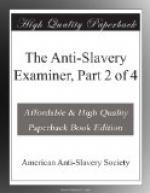We generally found the women at home. Some of them had been informed of our intention to visit them, and took pains to have every thing in the best order for our reception. The negro village on this estate contains one hundred houses, each of which is occupied by a separate family. Mr. H. next conducted us to a neighboring field, where the great gang[B] were at work. There were about fifty persons in the gang—the majority females—under two inspectors or superintendents, men who take the place of the quondam drivers, though their province is totally different. They merely direct the laborers in their work, employing with the loiterers the stimulus of persuasion, or at farthest, no more than the violence of the tongue.
[Footnote B: The people on most estates are divided into three gangs; first, the great gang, composed of the principal effective men and women; second, the weeding gang, consisting of younger and weekly persons; and third, the grass gang, which embraces all the children able to work.]
Mr. H. requested them to stop their work, and told them who we were, and as we bowed, the men took off their hats and the women made a low courtesy. Mr. Howell then informed them that we had come from America, where there were a great many slaves: that we had visited Antigua to see how freedom was working, and whether the people who were made free on the first of August were doing well—and added, that he “hoped these gentlemen might be able to carry back such a report as would induce the masters in America to set their slaves free.” They unanimously replied, “Yes, massa, we hope dem will gib um free.” We spoke a few words: told them of the condition of the slaves in America, urged them to pray for them that they might be patient under their sufferings, and that they might soon be made free. They repeatedly promised to pray for the poor slaves in America. We then received their hearty “Good bye, massa,” and returned to the house, while they resumed their work.
We took leave of Mr. Howell, grateful for his kind offices in furtherance of the objects of our mission.
We had not been long in Antigua before we perceived the distress of the poor from the scarcity of water. As there are but few springs in the island, the sole reliance is upon rain water. Wealthy families have cisterns or tanks in their yards, to receive the rain from the roofs. There are also a few public cisterns in St. John’s. These ordinarily supply the whole population. During the present season many of these cisterns have been dry, and the supply of water has been entirely inadequate to the wants of the people. There are several large open ponds in the vicinity of St. John’s, which are commonly used to water “stock.” There are one or more on every estate, for the same purpose. The poor people were obliged to use the water from these ponds both for drinking and cooking while we were in Antigua. In taking our morning walks, we uniformly met the negroes either going to, or returning from the ponds, with their large pails balanced on their heads, happy apparently in being able to get even such foul water.




